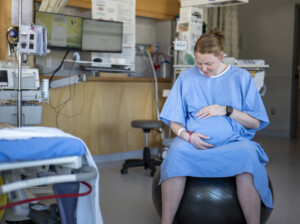Your labor experience isn’t always the way you expect it to be. I’ve given birth to five babies, including twins, and had an emergency Cesarean section. I have also delivered thousands of babies as a nurse midwife. Each delivery was different. I’ve made a list of things I wish I had known when I gave birth to my two oldest before I was a nurse. I’ve also included things my patients have said they wish they had known to prepare better.
Things I Wish I Knew Before My Labor Experience
Here are 14 things I wish I knew before my labor experience and things other women said they wish they knew before theirs.
1. Hospital Bag
It’s called a hospital bag because it’s not a suitcase! You don’t need to bring half your wardrobe, entertainment center, or kitchen appliances. Many expectant mothers haul way too much stuff to the hospital. Remember, you must move your belongings from triage to your labor room and again to postpartum.
A checklist can help you determine what to pack for your labor experience. Only bring your bag to the hospital once you know they have admitted you. Your support person can grab it for you.
2. False Labor
You may go to the hospital for labor and be sent home. It happens a lot! False labor contractions called Braxton Hicks can be confused for labor.2 Some women may visit the hospital several times before they’re admitted. You may also be sent home if your contractions are labor, but it is still very early.
Real labor contractions have the following characteristics:1,2
- Come at regular intervals
- Getting closer together
- Last 60-90 seconds
- Continue even when you rest or change positions
- Become stronger with each one
- The pain usually starts in the back and moves to the front
- There is often a bloody mucus discharge called bloody show
3. Birth Plans
Birth plans need to be renamed to birth preferences. It’s impossible to plan your birth. So many things can happen. You only know what you will want in labor once you are experiencing it.
It’s great to have ideas about how you would like to labor in a perfect situation. Writing out your thoughts helps you organize and communicate your wishes to your partner and healthcare team. Studies have found that women have more positive labor experiences when having a birth plan.3,4
However, keep in mind that you cannot plan for things such as:
- How your baby tolerates labor
- If you are exhausted or sick when you go into labor
- Back labor
- Prodromal labor
- Induction of labor
- Complications
The most important thing to plan for is that unexpected things will happen. The main goal of any plan should be the safety of you and your baby.
4. Get Out of Bed
Labor is easier if you can get up and move. Getting out of bed can help you have:5
- Faster labor
- Increased comfort
- Increased likelihood of giving birth vaginally
- Better sense of control
- Decreased need for pain medications
5. Get in the Water
One of the best places out of bed to labor is in the shower or tub. Being in the water has many advantages, including:6
- Decreased need for pain medications
- Promotes relaxation
- Increased energy
- More efficient contractions
- Improved blood circulation
- Decreased anxiety
- Reduced stress-related hormones
Many women don’t want to move once they are in bed. But they are much more comfortable once they are up, especially in water. I’ve repeatedly seen stalled labor pick up pace with movement and time in the water.
6. Support
You will need support, but possibly not how you thought. Maybe you have gone to birthing classes with your partner and read about coping with labor pains. You may imagine that you want massages and foot rubs. Then contractions hit, and you don’t want anyone to touch you.
Discuss how your partner can support you through labor and be prepared for various support techniques. If you have many options, you will find what works for you when the time comes.
7. Your Body is in Charge
During the labor experience, your body is in charge. You cannot stop or pause contractions. The different sensations you feel may be new and overwhelming. At times, you may feel out of control.
When I had my first baby, I imagined being calm and focused. I ended up screaming my baby out. The labor was very fast. I felt I didn’t even have time to come up with an idea of coping before the next wave started. After my daughter was born, I remember thinking, “Wait! I didn’t even get a chance to do my breathing techniques.”
8. Pushing
Pushing is usually hard work. At some point during their labor experience, most women will say, “I can’t do this! But somehow, you will. You will dig deep and find the strength and courage to push your baby out.
The pushing stage can be long. It is normal to push for up to three hours with your first baby and up to two hours when you have had a baby before.14 However, it usually takes much less time.
Even with an epidural, the urge to push is often intense. But some women don’t feel that urge and must learn how to bear down. I have heard many women say it was a relief to be able to push after going through labor. They could finally do something with the contractions.
9. Birthing Positions
The traditional position for pushing is on your back with your legs pulled back. While this position works for many women, there may be better options for your labor experience. Talk with your healthcare team and try different positions.
Any position where you are upright will allow gravity to help. When you are vertical, your pelvis has more room to open. When squatting, the bottom part of your pelvis has about 20% more space. Contractions are stronger and more effective, and women often find being upright more comfortable.7
Other positions that are beneficial are side lying and hands and knees. Side-lying can decrease your risk of tearing and make you more comfortable. Hands and knees allow your pelvis to open in all directions and may reduce tearing.7
10. Labor and Birth are Not Like TV
Birth does not fit neatly into 30 minutes like it does on TV. There are often hours of just waiting or working through contractions. The average first labor lasts 12 to 24 hours, from the first mild contractions to having your baby in your arms.9
Birth is often messy. Losing up to 500 ml of blood with a vaginal birth is normal.8 That is equal to about 2 cups of blood. Amniotic fluid, pee, poop, sweat, and vomit may also be present.
Birth is often noisy. Women make various noises during the labor experience, from moaning to grunting to screaming.
11. Delivering the Placenta
Your baby is finally in your arms. You cry happy tears that you are through with labor. But wait! You aren’t done yet. You still must deliver your placenta. It is normal to take up to 30-60 minutes after a vaginal birth.10 It often comes out within a few minutes.
Fortunately, your placenta is soft, not like your baby’s head. You may push a time or two to deliver it, but it’s nothing like pushing out your baby.
12. Stitches and Ice Packs
Okay, so now you are finally done. Not so fast! Between 53% and 79% of vaginal deliveries will result in some tearing.11 Those tears, or lacerations, usually need to be repaired. In my experience with labor, repairs can take three to four minutes to over an hour.
The good news is you have a new baby to hold and distract you. Your doctor or midwife will make you as comfortable as possible with the epidural you already have or by injecting local anesthetic.
Ice packs for your perineum after delivery will become your best friend. Using ice packs decreases your pain and swelling.13
13. Uterine Massage
Heads up. Nothing is comforting or relaxing about uterine or fundal massage.
As part of your labor experience, your nurse will check frequently to ensure your uterus is firm after birth. These checks are done by massaging your uterus through your abdomen. Massaging your uterus helps it to contract and decrease bleeding.12 This all sounds great, but it is not comfortable. It can be pretty miserable.
The best approach is to do your best to relax and take slow, deep breaths. If you fight the process, it will take longer and be more uncomfortable.
14. Your Nurses
Your labor and delivery nurses will be your biggest cheerleaders, educators, supporters, and comforters. Most parents are surprised at how much their labor nurses do for them.
If you appreciate your nurses, give them a thank-you note, treats, or another token of appreciation. Nurses cherish thank-you cards. I know many nurses who keep every one of them forever.
Every labor experience is different. No matter what, there will be surprises. There will likely be even more than a list can count, but be flexible and know that you can tackle whatever may come your way.













